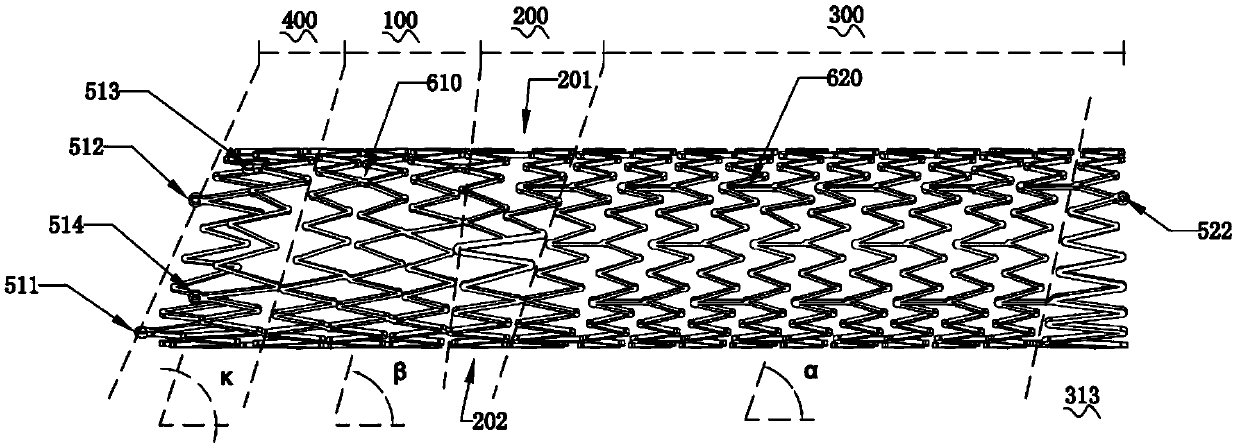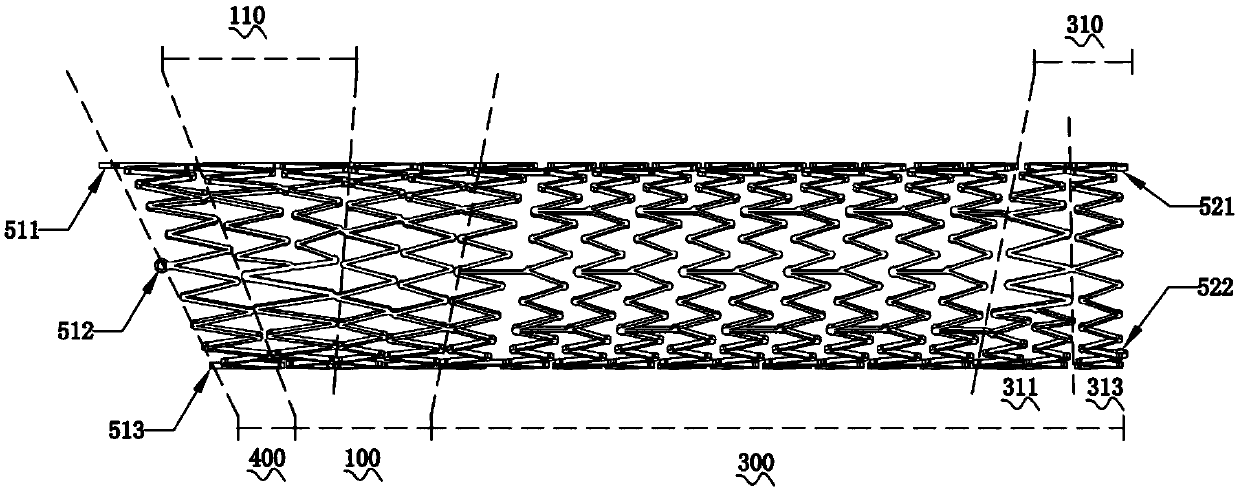Self-expandable stent and preparation method and application thereof
A technology of self-expanding and connecting components, which is applied in the field of self-expanding stent and its preparation, can solve the problem that the stent cannot meet the application requirements of the special lumen of the iliac vein, so as to better adapt to the shape of the blood vessel, enhance the anti-extrusion performance, and reduce the occurrence of rate effect
- Summary
- Abstract
- Description
- Claims
- Application Information
AI Technical Summary
Problems solved by technology
Method used
Image
Examples
Embodiment 1
[0065] This embodiment provides a self-expanding stent, which has two different types of helical sections that form a hollow tube and are arranged in the axial direction thereof, wherein the first helical section includes a single helix, and the second helical section includes two A double helix made of parallel helices. see Figure 1-Figure 3 , where 100 and 300 respectively show a first helical segment comprising a single helix and a second helical segment comprising two parallel double helixes.
[0066] And, the single helix and the double helix extend circumferentially in the same direction around the central axis of the tubular shape, and the adjacent ends of the single helix and the double helix merge in the transition zone between the two It is a single helix, and the other end of the single helix and the double helix are respectively closed along the circumferential direction of the tubular shape in another transition zone to form a closed loop without free ends.
[...
Embodiment 2
[0076] Based on the embodiment 1, the further improvement of this embodiment is that when the stent is in an unconstrained, stable and freely expanding state, the ascending angle of the single helix is not greater than the ascending angle of the double helix. The lift angle refers to the inclination angle of the tangent line at a point on the helix to the radial section of the stent. see figure 1 , the complementary angle of the lead angle of the double helix of the second helical segment 300 is α, that is, the helix angle of the double helix is α, and the complementary angle of the lead angle of the single helix of the first helical segment 100 is β, that is The helix angle of a single helix is β, α≤β.
Embodiment 1 or Embodiment 2
[0078] Based on Embodiment 1 or Embodiment 2, the further improvement of this embodiment is that the adjacent turns of the single helix are connected by the first connecting member to the crests and troughs with the closest distance, any helix in the double helix and its The two crests or two troughs with the closest distance are connected between adjacent helical wires by the second connecting part. The length of the first connecting part is significantly smaller than that of the second connecting part, so that the anti-extrusion performance and compliance performance of the aforementioned two helical sections are further enhanced respectively.
[0079] see Figure 1-4 , the first connecting part forms an included angle with the axial direction of the bracket, and the second connecting part is substantially parallel to the axial direction of the bracket.
PUM
| Property | Measurement | Unit |
|---|---|---|
| Length | aaaaa | aaaaa |
| Diameter | aaaaa | aaaaa |
| Diameter | aaaaa | aaaaa |
Abstract
Description
Claims
Application Information
 Login to View More
Login to View More - R&D
- Intellectual Property
- Life Sciences
- Materials
- Tech Scout
- Unparalleled Data Quality
- Higher Quality Content
- 60% Fewer Hallucinations
Browse by: Latest US Patents, China's latest patents, Technical Efficacy Thesaurus, Application Domain, Technology Topic, Popular Technical Reports.
© 2025 PatSnap. All rights reserved.Legal|Privacy policy|Modern Slavery Act Transparency Statement|Sitemap|About US| Contact US: help@patsnap.com



